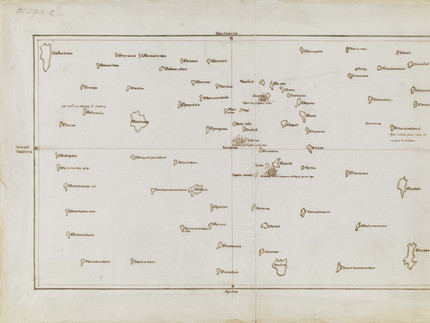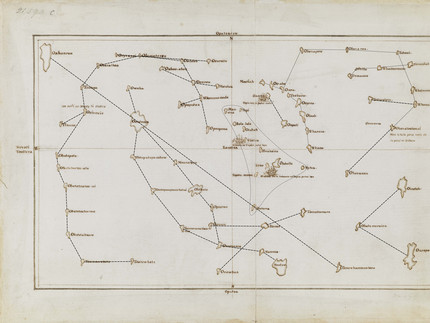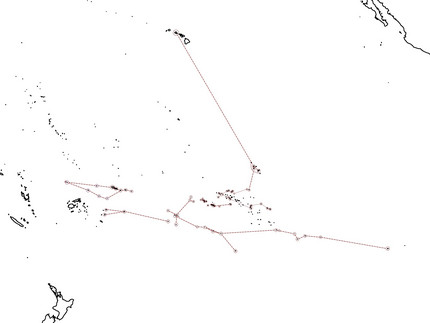Tupaia's Map
is one of the most famous and enigmatic artefacts to emerge from the early encounters between Europeans and Pacific Islanders. It was drawn by Tupaia, an arioi priest, chiefly advisor and master navigator from Ra‘iātea in the Leeward Society Islands in collaboration with various members of the crew of James Cook’s Endeavour in 1769/1770. For the past 250 years, the identity of many islands on the chart, and the logic of their arrangement have posed a riddle to researchers. We (Lars Eckstein and Anja Schwarz) spent several years of intense research on Tupaia’s Map. Drawing in part on archival material hitherto overlooked, we eventually proposed a new understanding of the chart’s cartographic logic. We argue that it shows interconnected voyaging paths ranging between roughly Samoa and Rapa Nui, and the Society Islands and Hawai‘i. Tupaia’s Map is a stunning feat of translation between two very different wayfinding systems and their respective representational models.
Our research on Tupaia’s Map is published in a book-length essay:
Lars Eckstein and Anja Schwarz, "The Making of Tupaia’s Map: A Story of the Extent and Mastery of Polynesian Navigation, Competing Systems of Wayfinding on James Cook’s Endeavour, and the Invention of an Ingenious Cartographic System", The Journal of Pacific History 54.1 (2019): 1-95.
It has been translated into French as:
Lars Eckstein and Anja Schwarz, La carte de Tupaia, maître d'astres et de navigation polynésienne, trans. and intr. Serge Dunis, Bulletin de la Societé des Études Océaniennes (Polynésie orientale) 348 (Mai/Août 2019). 153pp.
The Journal of Pacific History organised a review forum around our work, with invited commentaries by David Turnbull, Anne Salmond, Atholl Anderson and Erik Pearthree and Anne di Piazza. Our response to their commentaries is published as:
Lars Eckstein and Anja Schwarz, "The Making of Tupaia's Map Revisited", The Journal of Pacific History 54.4 (2019).
In early 2023 we published a short paper updating our research, most importantly to account for a voyaging path in the Cook Islands that we had missed in our earlier readings of Tupaia's Map. It is published as: "Corrections: An Update to ‘The Making of Tupaia’s Map’", The Journal of Pacific History 58.1 (2023).
Lars Eckstein built on the work on Tupaia's Maps since, trying to better understand the navigational system Tupaia himself would have used in voyaging, before he simplified and translated it into the form of a map for Cook and his crew. This research is pulished as: "Tupaia’s Wind Positioning System: (Re)Modelling Ancestral Polynesian Voyaging." The Journal of Pacific History, online first, pp 1-61.
It is translated into French as: "Le rua mata'i de Tupaia: (Re)modélisation de la navigation polyésienne ancestrale". Tr. Lars Eckstein et Hereata Pereyre. Bulletin de la Société des Etudes Océaniennes, Tahiti, 2025, n°365 (Janvier/Avril 2025): 5-109.
For readers who are interested in a short preview of our research on Tupaia's Map
here is a summary of the most important results, taken from Anke Bartels, Lars Eckstein, Nicole Waller and Dirk Wiemann, Postcolonial Literatures in English: An Introduction (Stuttgart: J.B. Metzler, 2019), pp 83-92 [page numbers in square brackets below indicate page breaks in the original]:
[Who, then, was Tupaia?]
Who, then, was Tupaia? Tupaia was an arioi priest from a Ra‘iātean family of master navigators in the Society Islands, born around 1725 and trained at Taputapu-ateamarae, the most important center for sacred knowledge and navigational learning in eastern Oceania. The marae would have preserved the oral legends and sailing instructions from Polynesian exploration voyages of the past 800 years which extended as far as to Hawai‘i in the North, Aotearoa/New Zealand in the South and Rapa Nui in the East. Around 1760, Ra‘iātea was invaded by warriors from the neighboring island of Porapora, and Tupaia had to flee to Tahiti, where he soon became a man of social standing. When the first Europeans, Captain Wallis and the crew of the Dolphin, set foot on Tahiti in 1767, Tupaia acted as chief diplomat. And two years later, after Captain James Cook spent three months in Tahiti on his first circumnavigation of the globe, Tupaia decided to join the crew of the Endeavour on their return voyage to Europe.
That Cook respected and trusted Tupaia is evidenced by the fact that for an entire month, he let Tupaia navigate his precious ship through the archipelago of the Society Islands, and on southward across open waters to Rurutu in the Austral Group. Tupaia turned out to be an invaluable linguistic and cultural translator for the crew, especially so in Aotearoa/New Zealand, where Cook landed next. Only when the Endeavour reached Australia did Tupaia’s powers to communicate fail; he eventually fell ill and tragically died in Batavia, today’s Jakarta in Indonesia.
When Cook and his crew first met Tupaia, their geographical knowledge of the South Pacific was very limited. On Tahiti, however, Tupaia shared with Cook and the ship master, Robert Molyneux, extended narratives of islands, both near and remote: Cook remarks that “he at one time gave us an Account of near 130” (1955, 293-94). It is easy to imagine how excited the Europeans must have been about all these islands, and how keen they were to learn their exact location. Cook, Molyneux, and Molyneux’s mate, Richard Pickersgill, must therefore have convinced Tupaia to embark on a joint project: A chart of the Pacific Ocean in which Tupaia could locate all the islands he claimed he knew.
Unfortunately, none of the original draft versions of the chart drawn “by Tupaia’s own hands” (1955, 293), as Cook insists in his diaries, have survived. But two quite different copies are still available in the archives. From this we can reconstruct that the map initially evolved in two stages.
The first stage resulted in a first draft containing 58 islands. As it was incomplete and later revised in a second draft, a junior officer, Richard Pickersgill was allowed to keep it. Pickersgill later took the map along on Cook’s second voyage to the Pacific on the Resolution (1772-1775), where he served as third lieutenant. There, he lent it to the German naturalist Johann Reinhold Forster and his son Georg. Georg Forster eventually included a copy (with slightly changed island names) of Tupaia’s first draft map in a letter to his publisher in 1776, which is today archived in the city archive of Braunschweig (Fig. 9.1). [image p. 84].
[p. 85] After the first draft was abandoned, Tupaia and his European collaborators started a new draft, presumably as part of the same drawing process in August 1769. Tupaia adjusted and corrected some elements, but basically took over all islands from the first draft, and added more (showing altogether 74). This map was kept by James Cook, who extensively describes it in his diaries. From archival evidence we cannot discuss here, it can be reconstructed that the second draft of Tupaia’s Map lay dormant in Cook’s papers for almost half a year, but that he worked with it again in the context of encounters with Māori people in Queen Charlotte Sound (Tōtaranui) in Aotearoa/New Zealand, in late January and early February 1770.
It is in this context also that the map was revised once more: The most significant addition at this third stage are annotations set down in Tahitian for five islands, which result from discussions between Tupaia, a local Māori chief called Topaa in European records, and Cook and his men. A major actor in this final draft stage must have been Cook’s famous naturalist on the first voyage, the gentleman scientist Joseph Banks. While the original draft drawn by Tupaia is again lost, Banks commissioned a fair copy of the third and final draft for himself. This copy survived in Banks’s papers in the British Museum in London(Fig. 9.2).
[The history of Tupaia’s Map]
The history of Tupaia’s Map, and the reconstruction of what it actually depicts, is extremely complex, and can only be puzzled together from a whole range of historical sources involving more charts, journal entries of diverse voyagers, records of island lists, and not least written and oral accounts of precolonial Oceanic wayfinding techniques and practices. Readers interested in the long story of Tupaia’s Map are invited to read the detailed, step-by-step reconstruction of when, by whom, how, and in which order it was drawn, and which knowledges exactly where contributed by Tupaia, Māori people and European collaborators in a book-length essay by Lars Eckstein and Anja Schwarz (2019). What we can offer here is only a very short account of the ways in which Tupaia devised his map.
For almost 250 years, Tupaia’s Map posed a riddle to historians, anthropologists and geographers of the Pacific alike. Until more recently, only a rather small number of islands on the map could be reliably identified. The British on Cook’s ship knew little Tahitian, and their linguistic talent was limited. They wrote down what they heard Tupaia say when he named the islands he drew, in an often very corrupted English transcription. What is more, many of the Tahitian island names are no longer in use in the region. But the more foundational problem is that even those islands which could be identified are hardly where one would expect them according to the logic of a Western map. By the standards of maps in Mercator projection as Cook used and drew them, the islands seem to be all over the place: Islands thousands of kilometers apart appear right next to each other, islands which should be to the south of Tahiti appear in the northern quadrants, small islands can have very large outlines, etc.
Already Georg Forster doubted Tupaia’s knowledge on this account during the Resolution voyage. He wrote: "if his drawing had been exact, our ships must have sailed over a number of these islands which he [Tupaia] had set down. It is therefore very probable that the vanity of appearing more intelligent than he really was, had prompted him to produce this fancied chart of the South Sea, and perhaps to invent many of the names of islands in it" (Forster 1777, 398).
In the second half of the 20th century, the map became a token in a heated debate about whether Polynesians had settled the Pacific by means of purposeful naviga- [image p. 86] [p. 87] tion or by accident (in drift voyages or blown off course by storms). Most notoriously, it was New Zealand historian Andrew Sharp who in the 1950s and 60s used Tupaia’s Map to back up a widely popular argument that Polynesians were incapable of purposeful long distance voyaging, and that their ancestral stories of migration are basically merely self-aggrandizing myth (Sharp 1956). How could anyone without a map or proper instruments such as compass and sextant find targets as small as most Polynesian islands in an ocean as vast as the Pacific? Not even Europeans, after all, could do this at the time, as their measurements of especially longitude (the vertical coordinate in the Cartesian system of Western geography) were very unreliable when at sea.
Tupaia’s rehabilitation as master navigator only came with a sustained decolonial movement and cultural renaissance across the region which strove to recover Oceanic knowledges displaced by imperialism and missionary activities. One part of this renaissance was to recover the ancient technique of Oceanic wayfinding. In Hawai‘i, for instance, Ben Finney and artist Herb Kane reconstructed and built a double-hulled sailing canoe, the Hokule‘a, and found one of the last remaining Micronesian master navigators, Mau Piailug, who volunteered to train the Hawai‘ian navigator Nainoa Thompson in ancient wayfinding techniques. In 1976, Thompson managed to sail the Hokule‘a from Hawai‘i to Tahiti without using Western instruments. The Hokule‘a and similar projects threw new light on Tupaia’s charts, as they foregrounded the fact that the crew of the Endeavour and Tupaia would have conceptualized maritime space in very different ways, and used very different techniques of navigational orientation.
Polynesian wayfinding in many ways inverted the globalized conception that travelers move in static, objectively surveyed and classified worlds. Rather, its core cognitive strategy has been to imagine the canoe as fixed in space, and to dynamise the world surrounding the traveler. Specific seasonal star, sun and wind positions provided situational and relational bearings for travel, memorized by master navigators with the help of long navigation chants. The resulting bearings on island-to-island voyages needed to be constantly reconfigured, to “the attribution of directionality to all the heterogeneous inputs from the sun, stars, winds, waves, reefs, birds, weather, landmarks, seamarks, and sealife.” And additional techniques to ‘fish up’ islands from the horizon came into play, first and foremost strategies of “expanding the target […] by looking for patterns of ocean swells, flights of birds, cloud formations, and reflections of the underside of clouds” (Turnbull 1997, 556).
Over the past 30 years, researchers on Tupaia’s Map accordingly began to suspect that the chart combines Western mapping conventions with distinctly Oceanic modes of geographic orientation, and that this is the main reason why the map has remained inconclusive to modern readers (Di Piazza and Pearthree 2007; Finney 1991, 1998; Turnbull 1997, 1998). Our brief account of how Tupaia’s Map was conceived draws on the continuation of this research by Eckstein and Schwarz (2019).
Georg Forster’s copy of the first draft of the chart suggests that it was the Europeans who began by setting it up for Tupaia. They took an empty sheet, entered the two cardinal axes indicating the directions of north and south and east and west respectively, and then drew the islands that they had themselves seen around Tahiti on the voyageof the Endeavour: These are the islands in the Society Group which on Forster’s copy appear as shaded, plus two more (Tupai, a small island in the north of the group, and Rurutu in the Austral Group south of Tahiti, labeled “Ohiteroa” on the chart). They drew these islands according to the way in which they [p. 88] were trained and used to do maps. This involves imagining an abstracted, central bird-eye perspective on Oceanic space that is thus fixed and strategically covered by an invisible grid of lines demarking latitude and longitude. As Cook and his men had previously (approximately) measured the coordinate positions of all of these islands using compass and sextant, they could confidently locate them on the chart they had set up, in fixed relations of direction and distance from each other. Then they asked Tupaia to take over, and to draw the other islands he said he knew, surely assuming that he would follow their cartographic model.
Tupaia, however, chose not to. Not, presumably, because he did not understand how the Europeans did their maps. He chose not to because their model was not compatible with the way in which Polynesians navigated, how they conceived of the relation between the traveler and the world, how they found the smallest islands across the vast Pacific without instruments or maps, drawing on a sophisticated astronomy, deep knowledge of the ocean, and a profound ancestral connection in oral tradition. In order to still be able to share his knowledge of Oceania with Cook and his crew, Tupaia therefore designed a completely new cartographic model from scratch.
For these purposes, Tupaia requested a little word at the center of his chart, precisely where the cardinal axes cross: e-avatea (“Eawatea”), signifying “the noon” in Tahitian. To cut a much longer story short: In Tupaia’s cartographic system, avatea marks a bearing to the north. It references the direction of the sun in its highest position at noontime (which south of the tropic of Capricorn, and most of the year south of the equator, points due north). Tupaia thus overrode the cardinal logic the Europeans set up for him: For the islands he subsequently drew, north would no longer be ‘up,’ east ‘right,’ south ‘down,’ west ‘left.’ North would from now on be in the center of the chart. What he thus also overrode is the logic of a singular, central perspective.
In Tupaia’s logic, there is no singular orientation abstracted from the traveller. True to his wayfinding tradition, the center of observation is always the va‘a (canoe). Rather than imaging an aloof bird-eye perspective, Tupaia must have invited his European collaborators to situate themselves in the chart, on a va‘a at any of the islands he subsequently drew.
The final key to understanding the new cartographic logic Tupaia set up is that he drew traditional voyaging paths, for travel from island to island. Where these paths are placed in the overall composition of the chart matters little: A path can essentially begin anywhere on the map. What matters, rather, is the relational position of islands to each other on such a path, in the sequence in which they are travelled to. An important guide for adequately reading Tupaia’s Map and to identifying the paths he drew is a list of islands Tupaia shared with Robert Molyneux already in Tahiti, and which Molyneux set down in his ship log in the order in which Tupaia recited them for him. It helps to understand which islands on the chart belong together on set routes, and which do not.
It is in this context, finally, that the little word avatea, for a northern bearing located in the center of the chart, comes into play: For Tupaia did not at all place his voyaging paths from island to island randomly. He translated his much more complex system of reckoning and wayfinding – an embodied practice using a whole range of variables from directional stars and constellations to seasonal winds, the angle of swell patterns to the hull, bird flight routes for island finding and many more – into something drastically less complex so Cook and his crew might understand. [p. 89] He basically translated the bearings for purposeful island-to-island travel into the logic of Cook’s compass.
[How Tupaia’s Map can be read]
This is how Tupaia’s Map can be read: Viewers are invited to situate themselves in basically any one of the islands Tupaia drew, and to then trace two imaginary lines from their position. The first points to avatea (the sun at noon) marked on the chart by the crossing of the cardinal axes (basically the direction to which the needle of Cook’s compass would point). The second imaginary line is toward the target island on a traditional voyaging route. The angle measured clockwise from the first to the second line, between the direction to avatea in the map’s center and the target island en route, provides the right bearing to set the course. It can be expressed in degrees from 0° to 360°, and thus translated into the terms of the Western compass.
Let us very briefly illustrate this with the perhaps most spectacular example, marking the by far longest single voyage on the chart from the Marquesas Group (northeast of Tahiti) to Hawai‘i (a voyage covering a distance of almost 4.000 km). The departure island is labeled Te-fenua-tane (spelled “Tenewhammeatane” by the European hand which took down the name next to the island shape Tupaia drew on the bottom right of the chart), “the land of men,” a name for the Marquesan Islands still in use in the region. The target island in the upper left corner is Oahu-roa, distant O‘ahu, the third largest island and political center of the Hawai‘i Group (spelled Oahourou on the map). To get their bearings from the Marquesas to Hawai‘i, readers of the chart need to situate themselves in the chart, at the island of departure. They then need to draw an imaginary line to their positional north, marked by avatea where the cardinal axes cross. They can then draw a second imaginary line from the island of departure to the target island. The clockwise angle between the two lines in this case is 335° on Georg Forster’s copy of the first draft map. It is 338° on the fair copy of the third draft which Banks kept. The true bearings from the Marquesas to O‘ahu as can be measured on a Western Mercator map of the Pacific Ocean are 330° NNW.
Tupaia’s system works with amazing precision for each island-to-island path on almost all the voyaging routes he set down (with one exception, namely in the Tuāmotuan archipelago ranging from the north to the east and southeast from Tahiti, for reasons we cannot elaborate on here). It is through the consistency of Tupaia’s cartographic system that eventually all islands on the map can be rather reliably identified, even where old names are no longer in use, or the English transcriptions are so corrupted that names can no longer be traced. Where there are deviations between true geographic bearings and the bearings in Tupaia’s own cartographic model, these may even be explained by the fact that for practical navigation, it would have been important to factor in leeway and drift, especially for voyages to the north and south, as the trade winds rather consistently blow from the east for most of the year in the corridor of the South Pacific where Tupaia’s islands (with the exception of O‘ahu in the North Pacific) are placed.
The trade winds also explain why the distance between islands on the voyaging paths Tupaia drew is no reliable marker of true distance. Polynesians exclusively measured distance by the time it took to travel, not, as Cook would have and as his maps indicated, by the geographic space they traversed. Tupaia, for instance, told Cook that a voyage from Rurutu in the Austral Group to Tonga (about 2.500 km to the west) takes “10 or 12 days in going thither and 30 or more in coming back” (Cook 1769, 108), as the return voyage was against the prevailing winds, and could [images pp. 90 and 91] [p. 91] only be done in a short period in summer when westerly winds occurred. As a function of time rather than space, and dependent on seasonal variation and direction of travel, distance was impossible to map for Tupaia, but would have been part of his oral commentary. In this spirit, the size of the island shapes on Tupaia’s chart [p. 92], too, does not correlate with the true geographic size of islands (but occasionally with questions of ritual and genealogical importance).
Tupaia’s Map is an absolute masterpiece of cross-cultural translation. Whereas the Europeans on Cook’s expedition failed to understand any of the complexities of Polynesian navigational practice, Tupaia must have acquired a rather thorough understanding of Cook’s navigational strategies. And he – who never saw or needed a map before he dealt with Cook and his crew – devised a cartographic system from scratch which allowed him to document the vast extent of Polynesian navigational knowledge in a Western representational form.
Basically, Tupaia’s Map shows two composite voyaging routes, one extending from west to east, and one extending from south to north. In the far west, the paths commence with two options for voyaging from Rotuma (north of Fiji) to the Samoan chain. A second segment connects two Tongan island groups south of Samoa with Rarotonga in the Southern Cook Islands. From here, the paths continue via the Austral chain to Mangareva and the Pitcairn Group, all the way to Rapa Nui (Easter Island). The composite voyage from west to east spans about a fifth of the circumference of the globe. The second major composite voyaging route leads from Tahiti via the northern Tuāmotus to the Marquesas Group, and from there, as already briefly illustrated, to distant Hawai‘i (see Figs. 9.3 and 9.4).
250 years after it was drawn, it is clear that Tupaia’s Map is not a result of failed cross-cultural communication, and not the phony work of someone who tried to appear “more intelligent than he really was” (Forster 1777, 398). The reason why it could not be received as a unique masterpiece and testimony to the profound navigational knowledge of Pacific Islanders was that critics in the Western academy only saw what they were conditioned to see when looking at a map, and for the longest time never questioned that there may be very different ways of conceiving and representing Oceanic space, based on very different ideas of being in and relating to the world.

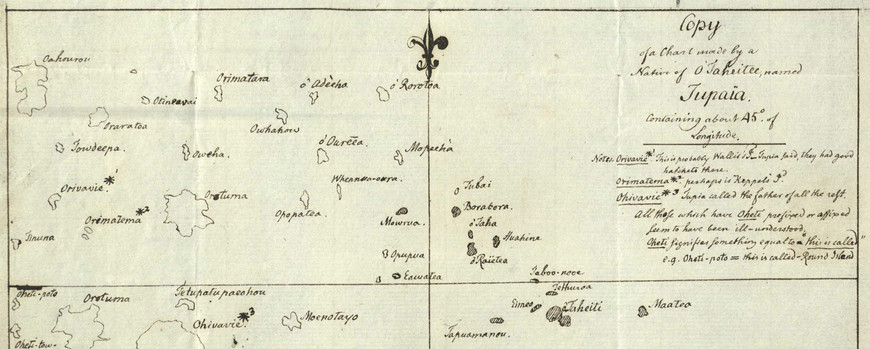

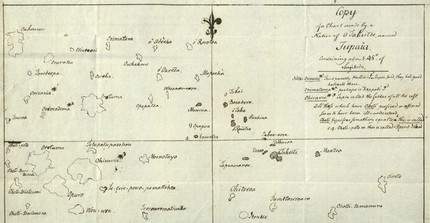

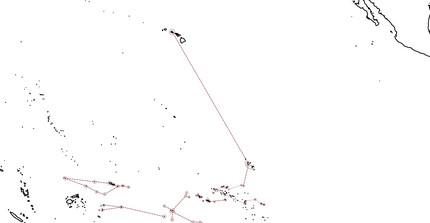
![Fig. 9.1. : “Copy of a Chart made by […] Tupaïa” by Georg Forster, 1776, Stadtarchiv Braunschweig, H III 16–87.](/fileadmin/_processed_/7/2/csm_Fig_9.1_-_Tupaia_s_Map_G_Forster_07_e0c8bc9d1d.jpg)
